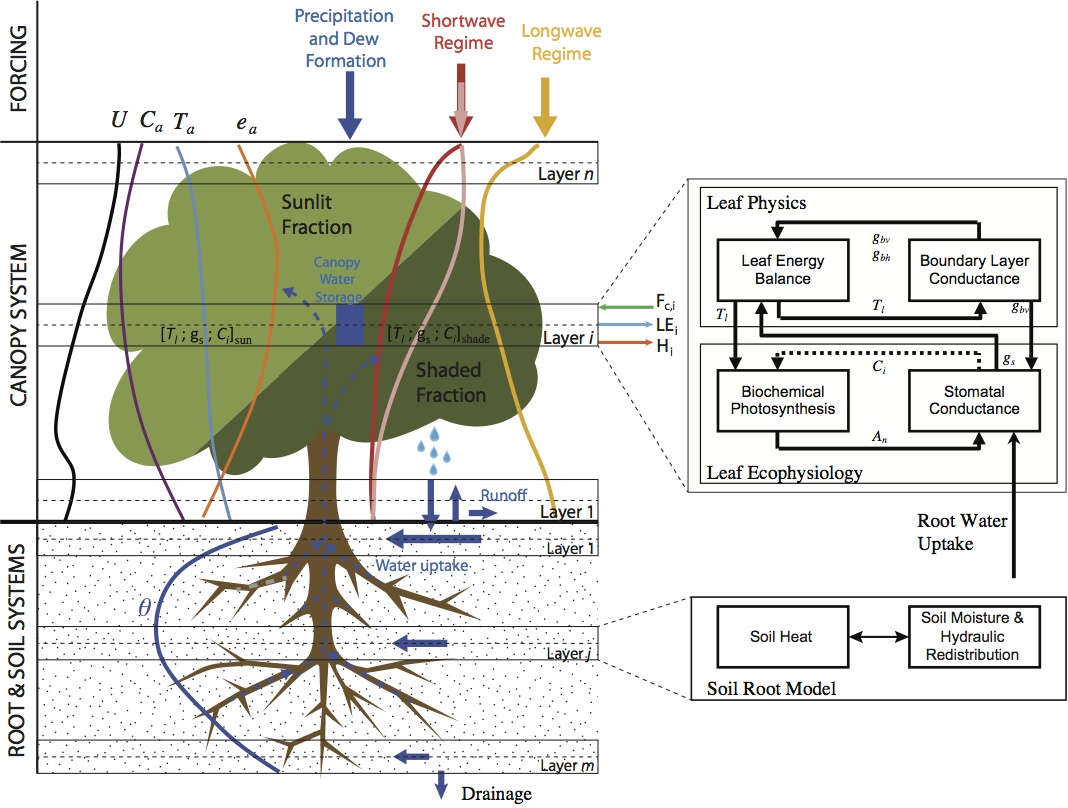Carbon-Water-Nutrient Cycle Interaction

Schematic of the canopy, root, and soil system (MLCan) model. Shortwave radiation components (photosynthetically active and near-infrared radiation) are attenuated through the canopy, accounting for absorbed, transmitted, and reflected fractions at each layer. Direct (red) and diffuse (pink) components of the shortwave streams are considered separately to account for sunlit and shaded leaf fractions at each canopy level. The longwave radiation regime accounts for absorption and emission by the foliage in each canopy layer. Transmitted radiation fluxes drive the soil temperature model. Wind speed is resolved within the canopy space, as are gradients in concentrations of CO2, water vapor, and heat. Rainfall and dew accumulate on foliage, resulting in evaporation and a reduction in throughfall to the soil. Rainfall and dew replenish the subsurface moisture store that supplies the root water uptake. A multilayer soil and root system model incorporating hydraulic redistribution are used to compute moisture uptake through the root zone. At leaf-level scale, ecophysiological (photosynthesis and stomatal conductance) and physical (boundary layer conductance and energy balance) components are coupled to determine the flux densities of CO2, water vapor, and heat as function of ambient environmental conditions and radiation drivers.
Introduction:
This research consists of two major themes. First, we examine the role of elevated CO2 in the atmosphere on vegetation and hydrologic response. Elevated CO2 in the atmosphere leads to a number of acclimatory responses in vegetation. These include structural changes such as, increase in vegetation height or foliage density, ecophysiological changes such as reduction in stomatal conductance, and biochemical changes such as photosynthetic down-regulation. Furthermore, the allocation of assimilated carbon to different vegetation parts such as leaves, roots, stem and seeds is also altered such that empirical allometric relations are no longer valid. These acclimatory responses have significant impact on hydrologic fluxes both pertaining to water and energy with the possibility of large-scale hydrologic influence. Our research develops models, rooted in observational data, for capturing the pathways of acclimatory response to provide accurate ecohydrologic predictions.
Second, we study the role of root-water uptake from hydraulic redistribution in shaping the above- and below-ground interactions in the critical. Hydraulic redistribution (HR) impacts the water and energy balance at the land-surface and affect belowground temperature and moisture profile. As a result they impact the carbon and nitrogen dynamics in the soil including residence times, transformations, storage and transport. Our models show how these dynamics occur at space and time scales and across climate gradients.
Key Publications:
1. Quijano, J. C., P. Kumar, and D. T. Drewry (2013), Passive regulation of soil biogeochemical cycling by root water transport, Water Resour. Res., 49, 3729–3746, doi:10.1002/wrcr.20310. - link to article
2. Quijano, J. C., P. Kumar, D. T. Drewry, A. Goldstein, and L. Misson (2012), Competitive and mutualistic dependencies in multispecies vegetation dynamics enabled by hydraulic redistribution, Water Resour. Res., 48, W05518, doi:10.1029/ 2011WR011416. - link to article
3. Le P. V. V., P. Kumar, D. T. Drewry, J.C. Quijano (2012). A graphical user interface for numerical modeling of acclimation responses of vegetation to climate change. Computers & Geosciences, 49: 91–101. - link to article
4. Le P. V. V., P. Kumar, D.T. Drewry (2011) Implications for the hydrologic cycle under climate change due to the expansion of bioenergy crops in the Midwestern United States. Proceedings of the National Academy of Sciences of the United States of America , 108, 15085–15090. - link to article
5. Drewry D. T., Kumar P., Long S. P., Bernacchi C. J., Liang X.-Z. & Sivapalan M. (2010a) Ecohydrological responses of dense canopies to environmental variability: 1. Interplay between vertical structure and photosynthetic pathway.
Journal of Geophysical Research 115, G04022. - link to article
6. Drewry D. T., Kumar P., Long S. P., Bernacchi C. J., Liang X.-Z. & Sivapalan M. (2010b) Ecohydrological responses of dense canopies to environmental variability: 2. Role of acclimation under elevated CO2.
Journal of Geophysical Research 115, G04023 - link to article